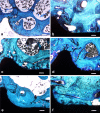In vivo preclinical evaluation of the influence of osteoporosis on the anchorage of different pedicle screw designs
- PMID: 21544593
- PMCID: PMC3175838
- DOI: 10.1007/s00586-011-1831-5
In vivo preclinical evaluation of the influence of osteoporosis on the anchorage of different pedicle screw designs
Abstract
We investigate the anchorage of pedicle screws with different surface treatments in osteoporotic bone. Eight ewes were divided into two groups of four animals each: four sheep underwent bilateral ovariectomy (OVX Group), whereas the operation was simulated in the remaining group (SHAM Group). Eighteen months after the first operation, the Dynesys(®) System was fitted to the sheep using pedicle screws with three different surface treatments: untreated, rough blasted (uncoated) and bioactive coated (bioactive). Uncoated screws showed a significantly higher bone ingrowth value compared with the untreated screws in the OVX group (9.3%, p < 0.005) and a significantly lower bone ingrowth value in the SHAM group (-11.0%, p < 0.05). Furthermore, the bioactive pedicle screws had a significant lower bone ingrowth value than the untreated screws in the SHAM group (-12.1%, p < 0.05). These results suggest that both tested surface treatments of pedicular screws may provide an advantage in terms of bone quality and osseointegration, when implanted in osteoporotic vertebrae.
Figures



Similar articles
-
Polymethylmethacrylate augmentation of the pedicle screw: the cement distribution in the vertebral body.Eur Spine J. 2011 Aug;20(8):1281-8. doi: 10.1007/s00586-011-1824-4. Epub 2011 May 1. Eur Spine J. 2011. PMID: 21533852 Free PMC article.
-
Pedicular fixation in the osteoporotic spine: a pilot in vivo study on long-term ovariectomized sheep.J Orthop Res. 2002 Nov;20(6):1217-24. doi: 10.1016/S0736-0266(02)00069-4. J Orthop Res. 2002. PMID: 12472232
-
[Augmented posterior instrumentation for the treatment of osteoporotic vertebral body fractures].Oper Orthop Traumatol. 2012 Feb;24(1):4-12. doi: 10.1007/s00064-011-0098-7. Oper Orthop Traumatol. 2012. PMID: 22297474 German.
-
Pedicle screw augmentation in osteoporotic spine: indications, limitations and technical aspects.Eur J Trauma Emerg Surg. 2017 Feb;43(1):3-8. doi: 10.1007/s00068-016-0750-x. Epub 2016 Dec 19. Eur J Trauma Emerg Surg. 2017. PMID: 27995283 Review.
-
[Techniques to increase pedicle screw stability in osteoporotic vertebrae].Oper Orthop Traumatol. 2019 Aug;31(4):284-292. doi: 10.1007/s00064-019-0608-6. Epub 2019 Jun 3. Oper Orthop Traumatol. 2019. PMID: 31161242 Review. German.
Cited by
-
Clinical Trial for the Safety and Feasibility of Pedicle Screws Coated with a Fibroblast Growth Factor-2-Apatite Composite Layer for Posterior Cervical Fusion Surgery.J Clin Med. 2023 Jan 26;12(3):947. doi: 10.3390/jcm12030947. J Clin Med. 2023. PMID: 36769595 Free PMC article.
-
Hydroxyapatite Use in Spine Surgery-Molecular and Clinical Aspect.Materials (Basel). 2022 Apr 15;15(8):2906. doi: 10.3390/ma15082906. Materials (Basel). 2022. PMID: 35454598 Free PMC article. Review.
-
Estrogen deficiency does not decrease the in vitro osteogenic potential of rat adipose-derived mesenchymal stem cells.Age (Dordr). 2014 Jun;36(3):9647. doi: 10.1007/s11357-014-9647-y. Epub 2014 Apr 1. Age (Dordr). 2014. PMID: 24687841 Free PMC article.
-
An Anesthesia, Surgery, and Harvest Method for the Evaluation of Transpedicular Screws Using an In Vivo Porcine Lumbar Spine Model.J Vis Exp. 2017 May 31;(123):55225. doi: 10.3791/55225. J Vis Exp. 2017. PMID: 28605377 Free PMC article.
-
Preclinical and Translational Studies in Small Ruminants (Sheep and Goat) as Models for Osteoporosis Research.Curr Osteoporos Rep. 2018 Apr;16(2):182-197. doi: 10.1007/s11914-018-0431-2. Curr Osteoporos Rep. 2018. PMID: 29460175 Review.
References
-
- Boden SD. Bone repair and enhancement of clinical trial design: spine applications. Clin Orthop. 1998;355:336–346. - PubMed
Publication types
MeSH terms
LinkOut - more resources
Full Text Sources
Medical

